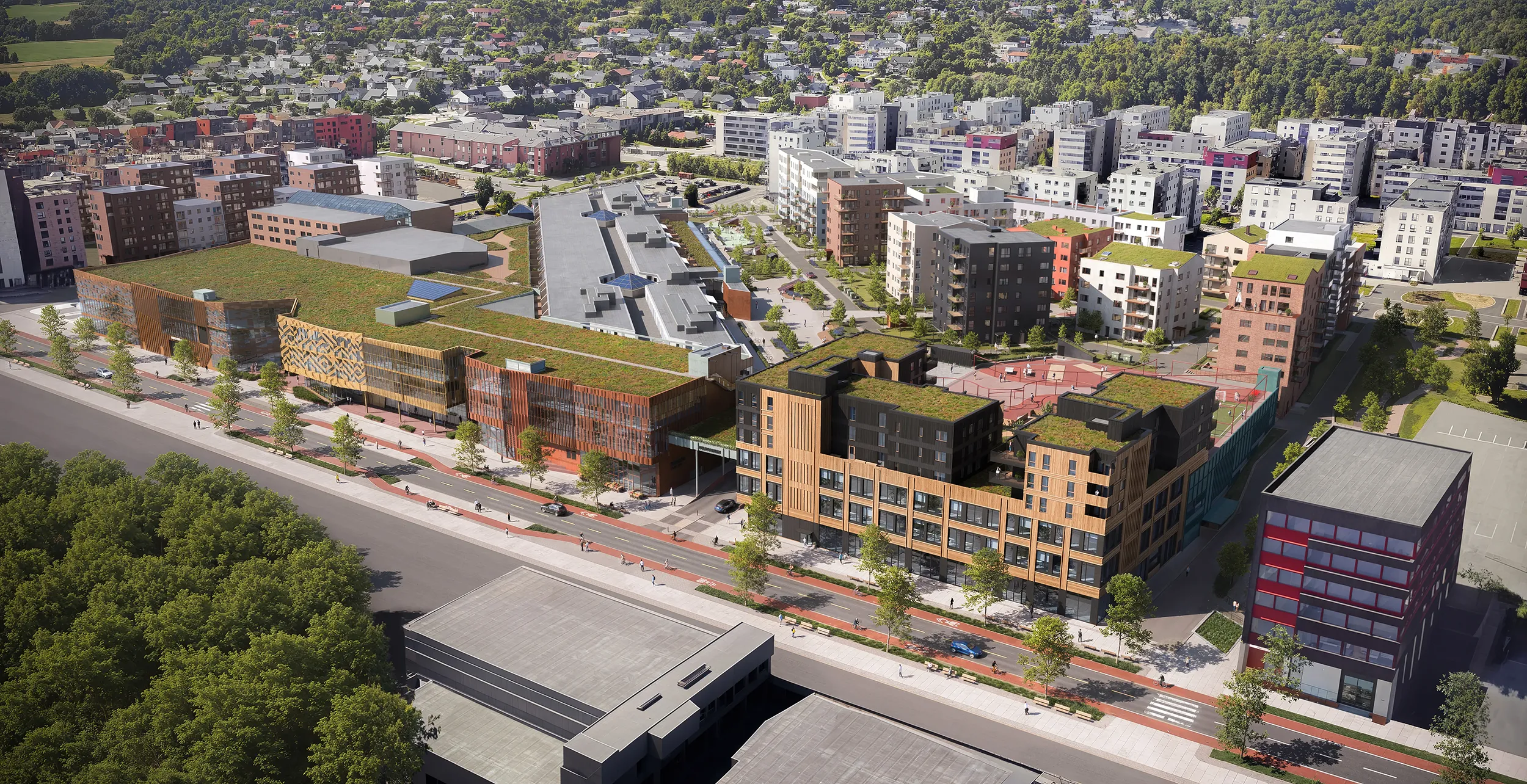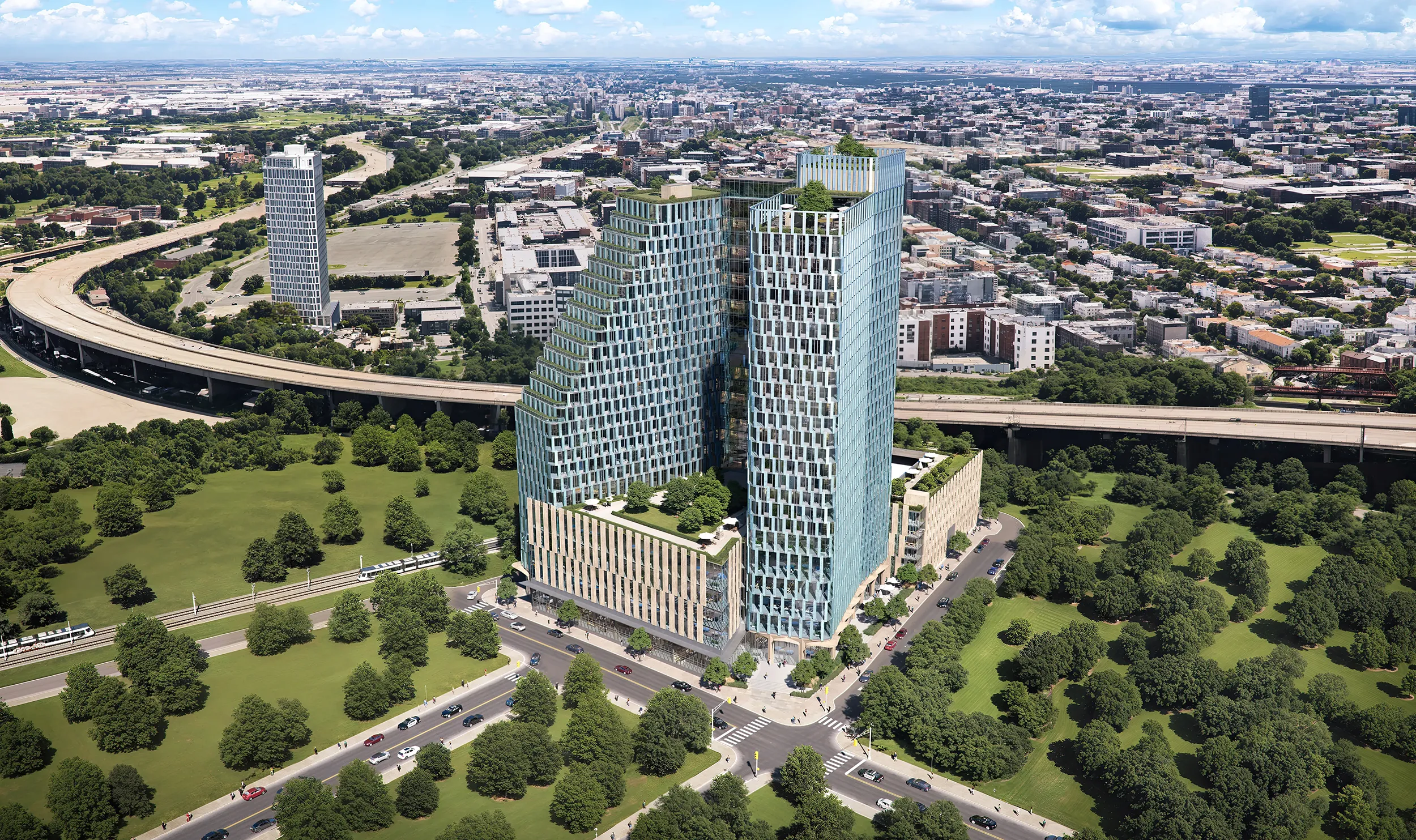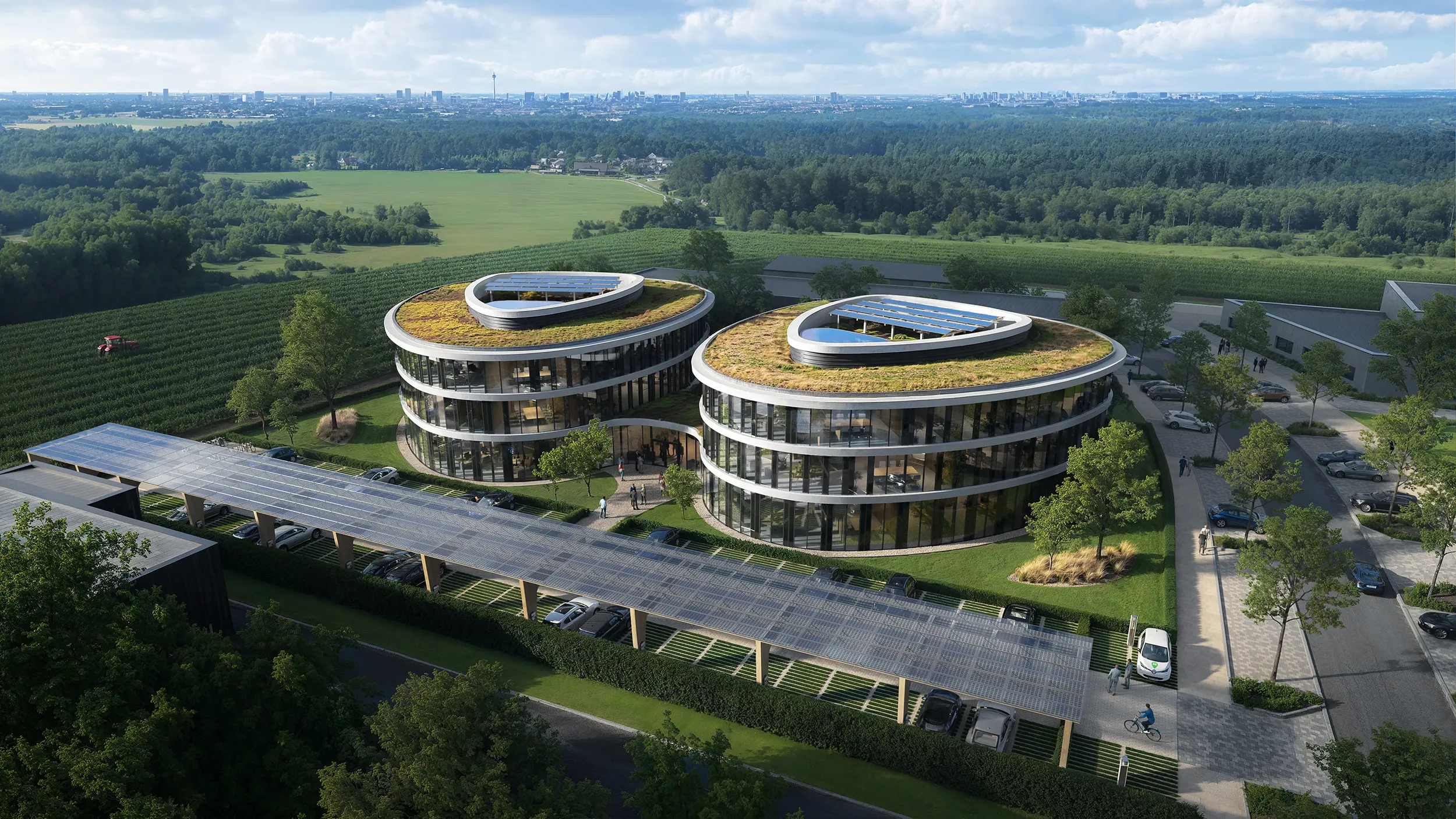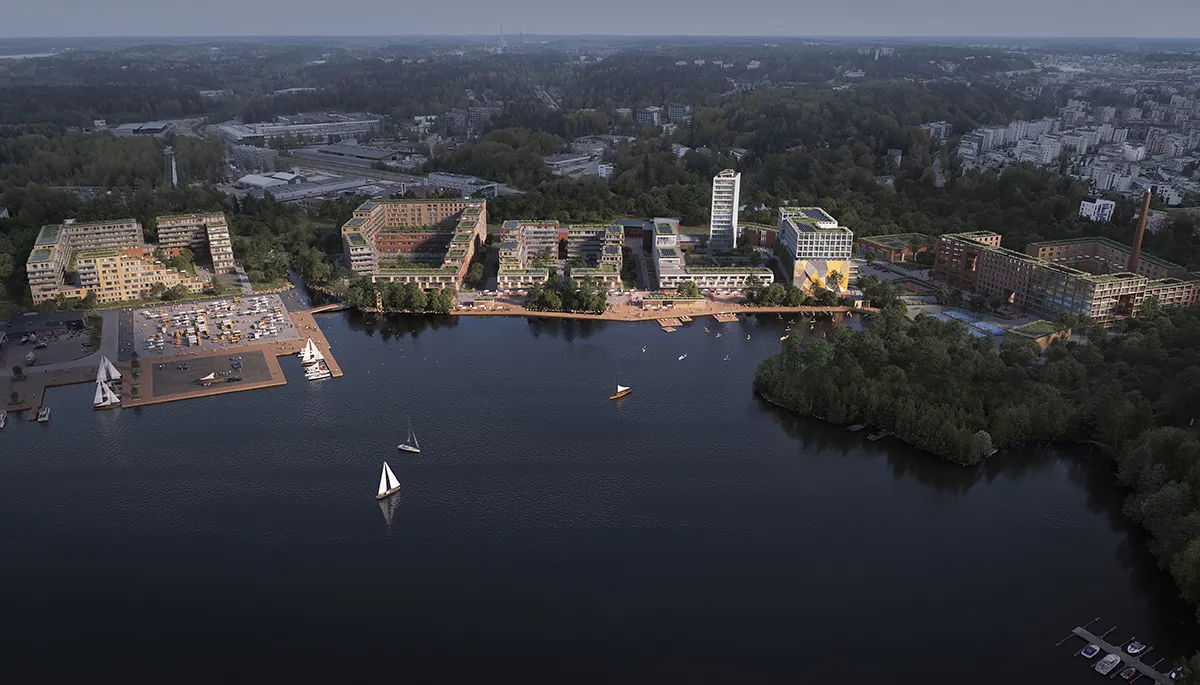You can spend hours explaining where a park will be built, how conveniently a pedestrian can reach the metro, and why this tower will harmoniously fit into the city skyline. Or you can show it all in a single frame, from a bird’s-eye view.
But when construction hasn’t yet begun, and the project already needs to be “shown from above,” a drone is useless. So what then?
That’s when bird’s-eye view rendering comes into play. Bird’s-eye view rendering is a precise architectural visualization that depicts the object in orthographic or axonometric projection with an aerial photography effect, and it is often crucial for creating detailed seasonal presentations, including powerful winter 3d renders.
This angle allows you to see not just the building, but the entire area: infrastructure, zoning, neighboring developments, and transportation accessibility.
It turns a paper-based project into a compelling commercial asset. This article explores how bird’s-eye view rendering works, where it delivers the most value, and why it’s becoming an indispensable tool for developers and architects.

Bird’s-Eye View Rendering as a Strategic Asset in Architecture and Real Estate
Investors are not willing to finance what they can’t see as a whole. Urban planning committees require clarity on how the project will impact transportation, surrounding neighborhoods, and the visual character of the area.
Developers lose time and resources on revisions because they can’t convey the project’s scale and logic.
Marketing struggles when there’s no cohesive visual story to engage potential buyers at first glance.
Bird’s-eye view renderings solve all of these issues — they provide strategic clarity at every stage, from planning to promotion.
The Role of Bird’s-Eye View Renderings in Investor and Stakeholder Communication
Investors and stakeholders do not make decisions in visual uncertainty. Their key concerns include underestimated risks, misunderstood surroundings, and a lack of clarity about the project’s scale and logic. Bird’s-eye view visualization eliminates blind spots in understanding, as stakeholders see not just a set of volumes but the urban context.
Supporting Project Approvals and Urban Planning Presentations
Bird’s-eye architectural renderings address the key need of public officials — to see how a project fits into the urban fabric: in terms of height, zoning, accessibility, and infrastructure load. That’s why teams using this tool get approvals faster, receive fewer remarks, and significantly increase their chances of success from the earliest stages.
Driving Competitive Advantage for Real Estate Developers and Builders
In an overheated market, the winner is the one who “packages” the project better than others. Bird’s-eye view rendering helps developers stand out. When a project is understood at first glance, it sticks in memory, builds trust, and gets the right response.

Core Capabilities of Bird’s-Eye Rendering in Visualization Workflows
A single bird’s-eye angle gives a strategic overview but doesn’t answer every question. Each audience has its priorities: investors care about phasing logic, officials — about infrastructure, and buyers — about environmental detail. To be effective, visualization must be reinforced by other formats: plans, animations, walkthroughs, and exterior views. Combined, they deliver a complete understanding of the project — from scale to specific user experience.
Integration with 3D Walkthrough, Floor Plans, and Township Rendering
Some spaces only make sense when walked through. A 3D walkthrough lets you test the rhythm, proportions, and transitions before construction. An architectural walkthrough company creates these visualizations to make complex or layered layouts readable in motion.
Floor plans give structure. They show how rooms relate, how access works, how the logic holds together. Without them, visuals look nice but don’t explain anything. We use plans to anchor every visualization.
For larger projects — townships, residential blocks, masterplans — Site Plan Rendering Services help show the whole picture: phases, roads, public spaces, and how everything connects. It’s not about decoration — it’s about understanding scale and flow.
A professional 3D visualization company delivers everything from interior rendering and apartment visualization to full walkthroughs, bird’s-eye view rendering, and site-scale imagery — all consistent in language and logic, from the smallest room to the full plan.
Enhancing Site Context with Aerial View and Exterior Rendering
3D Exterior Rendering Services showcase architectural elements such as facades, entry points, and material articulation, reinforcing the project's design logic. When integrated with 3D Aerial View Rendering Services, these visuals construct a coherent narrative that anchors the building within its urban context and conveys both spatial intent and environmental relationship. For high-rise developments, especially in dense urban environments, combining bird’s-eye perspectives with Skyscraper Rendering Services helps emphasize verticality, skyline impact, and integration with surrounding architecture.
Synergy Between Virtual Tours, 3D Animation, and Bird’s-Eye View
Bird's-eye view renderings excel at showing a project’s scale, structure, and surroundings, especially in early stages. But once there’s a need to deepen audience engagement, convey environment dynamics, or explain complex functions, a bird’s eye alone isn’t enough. 3D animation shows how the space functions throughout the day: people moving, traffic flow, and public spaces in use. Virtual tours allow a human-scale experience — walking through a courtyard, entering a lobby, and sensing the scale and atmosphere.

Business Use Cases and ROI of Bird’s-Eye View Rendering Services
Where does visualization truly impact business? Wherever there’s a need to sell the idea before construction begins, shorten the approval process, and kick-start marketing.
How Builders Leverage Aerial Rendering for Faster Buy-In
At the buy-in stage, the goal is to show that the project is feasible — spatially, technically, and economically. Investors, city officials, and partners want to see how it works: how the land is zoned, how access is organized, how phases are sequenced, and how the project fits into its surroundings. Bird’s-eye rendering communicates all of this in one frame.
In commercial development, aerial visuals also support strategic transitions. With demand for sustainability rising, and 9 out of 10 institutional investors in Europe planning to increase spending on retrofits, developers need to show how existing assets will evolve — structurally and spatially. Bird’s-eye renderings make these changes legible: not just in façades, but in circulation, energy use, and overall site logic. When used in early-stage presentations, they help turn long-term ESG goals into visible, fundable scenarios.
Visualizing Large-Scale Developments for Pre-Sales and Marketing
In pre-sales, there’s no building yet, but selling has already started. Buyers, agents, and partners need to understand what kind of place is being built. In multi-phase developments — residential districts, mixed-use clusters, countryside settlements — the lack of spatial clarity slows everything down. Conversion drops. Sales teams spend time explaining what could be shown in a second.
Bird’s-eye renderings fix this. They visualize the key elements buyers care about: where homes are, how green areas are integrated, how streets connect, and what phases come first. Research from JLL shows that 88% of homebuyers prioritize access to green space, and green areas are the most visited amenity in cities across Europe and Asia. When these spaces are visible and well-placed in the visual narrative, they directly support demand.

Selecting a Bird’s-Eye View Rendering Partner for Long-Term Collaboration
Long-term collaboration with a single visualization team saves resources at every stage: there’s no need to re-explain planning structure, zoning, or site constraints. A partner familiar with the project adapts quickly to revisions, understands the strategy, and builds visual content aligned with investment, approval, and marketing goals. To make the right choice of provider, several key factors should be considered.
Evaluating Technical Competence and Architectural Visualization Experience
A professional visualizer must understand architecture: read drawings, work with planning logic, and account for zoning, density, and structure. Bird’s-eye rendering requires not decor, but accurate visual representation of the design intent. A major advantage is if the team has a background in architecture or urban planning. Such specialists dive into tasks faster, view the project as a system, speak the architect’s language, and preserve meaning in visual delivery.
Budgeting, Project Timelines, and Revision Workflows
When discussing terms, it’s important to define budget and deadlines as the revision process: who sets tasks, what changes count as iterations, and where the line is between tweaks and a new version. Equally worth considering is how the workflow is structured and maintained: how disciplined the team is in communication, how it documents received feedback, and how well it aligns results with the brief.
Case Study Snapshot: From Concept to Approval Using Bird’s-Eye Rendering
When selecting an architectural visualization provider, the portfolio should showcase more than visual polish — it must demonstrate the team’s ability to interpret architectural intent, understand context and scale, and convey functional logic. Our studio often collaborates with developers and architecture firms on bird’s-eye renderings.
One notable project was developing a competition concept for the architectural bureau Davidsson Tarkela. The project involved transforming a 15.5-hectare industrial waterfront site in the Niemi area on the shores of Lake Vesijärvi, Finland, into a sustainable residential district with a 20-year development horizon.
Our team was responsible for creating the bird’s-eye visualization, which presented the spatial structure of the future development, showed its integration with the natural environment, and illustrated a realistic vision for comprehensive district evolution. The visual material became a key element of the competition submission and enhanced the perception of the architectural concept.

All images © CYLIND
